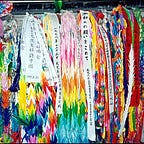Japanese and Chinese names throughout are given in Japanese and Chinese order, in which the surname precedes the given name.As for the spellings of Chinese names, mainly the Pinyin system is used. However, the Wade-Giles system is also employed for words still commonly used: for instance, "Chiang Kai-shek" instead of "Jiang Jieshi." Words like "Nanjing" and "Nanking" are regarded as interchangeable.This article is part of the online project The Nanjing Massacre.
Introduction I: Battle of Shanghai
Precipitated by a skirmish between Japanese and Chinese troops at Lugouqiao (Lu-kou-ch’iao), or the Marco Polo Bridge, on the outskirts of Beijing on July 7, 1937, the bilateral conflict between the two nations developed into a full-scale war.
During the early stage of the “North China Incident,” the Imperial forces of Japan quickly captured major cities in northern China and advanced southward.
By mid-August the mutual hostility, which had been growing since Japan’s conquest of Manchuria in 1932 and the subsequent formation of the puppet Manchukuo regime, inevitably goaded the two countries into another war in central China as well, involving one of the most developed, international cities in Asia, Shanghai.
At this point the Second Sino-Japanese War that eventually bogged down the two neighboring countries in a bloody, eight-year-long war became irreversible.
Having tasted easy victories in northern China, the Japanese Army and Navy apparently underestimated the Chinese troops in Shanghai, but that expectation soon proved to be a wrong one.
That August the Japanese troops found themselves at a major standstill as they encountered stern resistance by the Chinese main forces, while the Japanese government clung to the hope that the Chinese forces could be easily subdued.
House-to-house fighting broke out, bombs detonated in the war-shattered city and naval gunfire backed up the infantry units. Both sides continuously reinforced their troops in order to make up their losses.¹
The war in Shanghai was indeed a decisive battle that caused both sides exorbitant damages, left them with a deep-rooted loathing for each other, and begot vengeance.
Many historians today say the Battle of Shanghai nurtured the psychological conditions for Japanese soldiers to go on a berserk rampage in Nanking later on.²
A sergeant from the Amadani Detachment of Japan’s 11th Division, for instance, described what he saw when the unit made a landing at Wusong on September 3. His postwar memoirs partly read:
I crawled up onto the embankment at Wusong and beheld the sight of perdition. It was brutal. A bloodbath in the battlefield of Ashura [a demon who is eternally fighting] couldn’t have been merciless like this. As far as my eyes could see, there was corpse after corpse on top of the embankment, heaps of which covered the entire ground.
The bodies of thousands of soldiers were all piled up in a jumble just like blue-fin tuna in a market. A nauseating stench of death assailed my nostrils. This was what had become of the officers and men of the 3rd Division from Nagoya…. They must have been mowed down the moment they landed. These soldiers must have died without knowing what was happening to them….
Due to the decay of the internal organs, all the bodies were in ferment and swollen up, and the soft parts of the bodies had gushed out by pressure, such as the eyeballs bulging five or six centimeters [about 2 inches] out of their faces.³
The fierce battle in Shanghai ended in mid-November when a successful landing of Japan’s 10th Army at Hangzhou Bay in the south, and of the 16th Division at Baimaokou in the north, threatened the Chinese forces’ flank and forced them to withdraw to the west. The General Staff Headquarters in Tokyo, which had been concerned about the exhausted troops and their declining military discipline, decided not to expand the war front any further.
However, on November 19, the 10th Army led by Lieutenant General Yanagawa Heisuke cabled to the Headquarters, “The group [the 10th Army] commanded [its troops] to put on a spurt in pursuit [of the retreating Chinese] to Nanking.”
The second in command of General Staff, Lieutenant General Tada Shun, was surprised to receive the message. He immediately ordered a stop to the arbitrary act, which turned out to be of no avail.
Three days later, the Central China Area Army (CCAA) that supervised the 10th Army also sent a report that emphasized the necessity to attack Nanking. On December 1, 1937, the Imperial Headquarters, which had just been established as the highest authority on strategic matters in the “China Incident” in late November, finally ordered the CCAA to capture “the capital of the enemy state.”
Meanwhile the Imperial Headquarters reappointed General Matsui Iwane as the commander-in-chief of the Central China Area Army and newly appointed Lieutenant General Prince Asaka Yasuhiko, Emperor Hirohito’s uncle, to take command of the Shanghai Expeditionary Force that made up the CCAA along with the 10th Army.⁴
[Footnotes]
- Frank Dorn, The Sino-Japanese War, 1937–41: From Marco Polo Bridge to Pearl Harbor (New York: Macmillan Publishing, 1974), 69–78.
- See, for instance, Akira Fujiwara, Nanking no Nihongun [The Japanese Army in Nanjing] (Tokyo: Otsuki Shoten, 1997), 18; Yutaka Yoshida, Tenno no Guntai to Nanking Jiken [The Emperor’s Military and the Nanjing Incident] (Tokyo: Aoki Shoten, 1986), 42–43; Ikuhiko Hata, Nanking Jiken [The Nanjing Incident] (Tokyo: Chuo Koron, 1986), 67.
- Quoted in Katsuichi Honda, Nanking he no Michi [The Road to Nanjing] (Tokyo: Asahi Bunko, 1989), 41–44.
- Hata, Nanking Jiken [The Nanjing Incident], 73–78; Fujiwara, Nanking no Nihongun [The Japanese Army in Nanjing] 23–25; Yutaka Yoshida, Tenno no Guntai to Nanking Jiken [The Emperor’s Military and the Nanjing Incident] 66–70; Tokushi Kasahara, Nanking Jiken [The Nanjing Incident] (Tokyo: Iwanami Shoten, 1997), 62–71.
